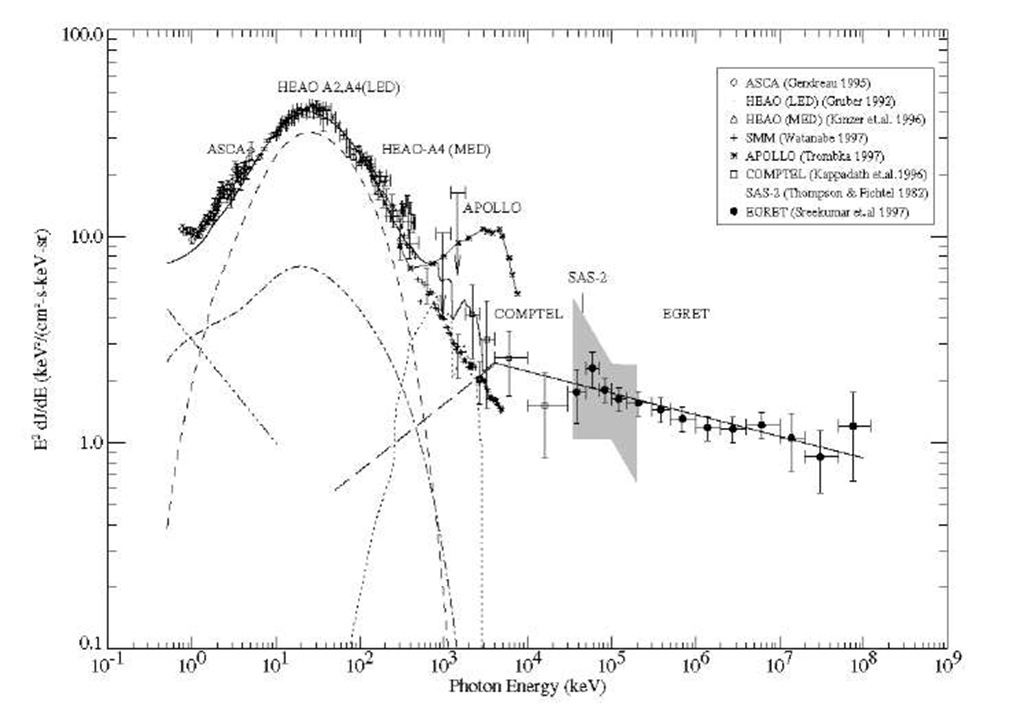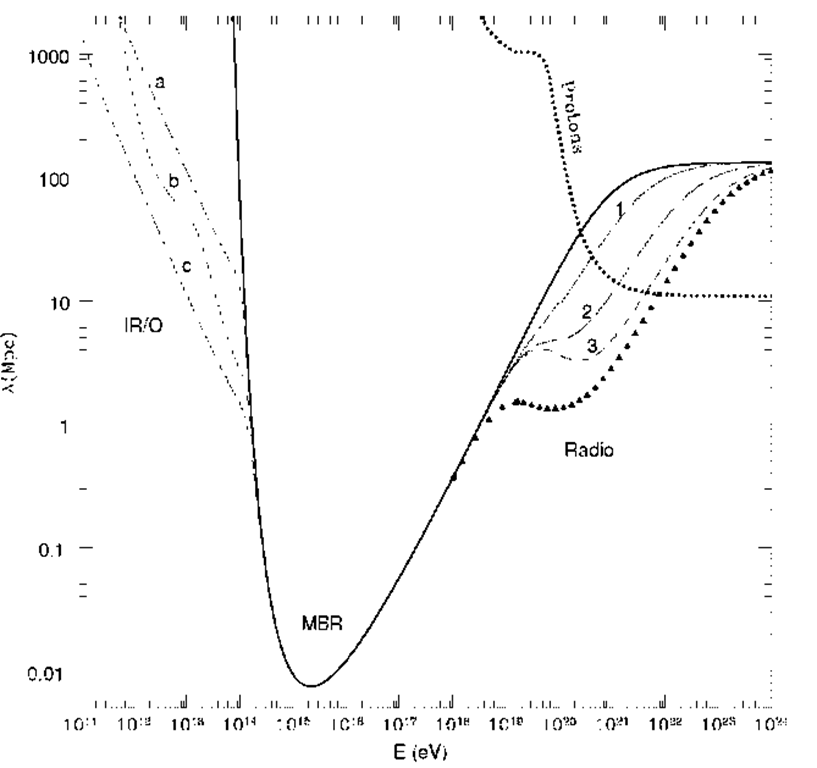Returning back to the question of the "last window", we notice that it covers at least 14 decades in frequency ! The energy domain of gamma-ray astronomy spans from approximately![]()
The lower bound characterises the region of nuclear Y-ray lines, as well as the electron-positron annihilation line. The second bound characterises the energy of highest energy particles observed in cosmic rays. This limit can be also interpreted as the maximum energy of protons and nuclei that can be achieved in conventional cosmic ray accelerators. The interactions of protons with surrounding gas or radiation fields should unavoidably lead to production of Y-ray photons of comparable energy. In fact, much higher (by two or three orders of magnitude) energy Y-rays can be in principle produced due to the collapse or decay of hypothetical very massive relic particles.
This enormous energy band of cosmic electromagnetic radiation is covered rather inhomogeneously in the sense of essentially different detection methods and flux sensitivities of space- and ground-based instruments. Therefore it is convenient to introduce several sub-divisions, taking into account the specific astrophysical objectives and detection methods relevant to different energy bands. Generally, the observational gamma-ray astronomy can be divided into 6 areas – low (LE: below 30 MeV), high (HE: 30 MeV – 30 GeV), very high (VHE: 30 GeV – 30 TeV), ultra high (UHE: 30 TeV – 30 PeV), and finally extremely high (EHE: above 30 PeV) energies. The "keV … EeV" symbols characterise the most commonly used energy units in high energy astrophysics and imply:![]()
While observations in the first two energy bands are covered by satellite- or balloon-borne detectors, the last three energy intervals can be best addressed with ground-based instruments. It should be noticed, however, that the term "astronomy" presently can be adequately applied, strictly speaking, to the activities in the LE, HE, and VHE energy domains. The significant efforts in the past unfortunately did not not result in detection of UHE and EHE 7-ray sources, although presently we cannot exclude that a fraction of highest energy cosmic rays detected beyond the so-called GZK cutoff may have photonic origin.
Only a limited fraction of the Universe is available for 7-ray observations in the VHE, UHE and EHE domains. The 7-ray horizon of the Universe is strongly energy-dependent (see Fig. 1.4). It is determined by interactions of 7-rays with the diffuse extragalactic photon fields. For example, the mean free path of 7-rays less than several GeV exceeds the Hubble size of the Universe, whereas the free path of 1 PeV 7-rays is only 8.5 kpc. This implies that all objects beyond our Galaxy are not visible in PeV 7-rays. The visibility range increases up to several 100 Mpc for TeV 7-rays and « 10 Mpc for 100 EeV. Only by reducing the energy threshold of detectors down to 100 GeV can we approach cosmological distances corresponding to redshifts z ~ 1. And finally, in order to detect 7-rays from the most distant quasars with redshifts z > 3 the energy threshold of detectors should be reduced to 10 GeV and lower.
Fig. 1.3 Diffuse extragalactic X- and 7-ray backgrounds
Thus, cosmological epochs cannot be directly probed with TeV and higher energy Y-rays. When a high energy Y-ray photon is absorbed, its energy however is not lost. Their interactions with extragalactic radiation fields initiate electromagnetic cascades which lead to formation of huge (> 10 Mpc) nonthermal structures like hypothetical (not yet detected) ultrarelativistic electron-positron Pair Halos. Actually, the entire Universe is a scene of continuous creation of electromagnetic cascades. All cosmic Y-rays above several GeV have a similar fate. Sooner or later they terminate on Hubble scales. The superposition of contributions of Y-rays from these cascades should constitute a significant fraction of the diffuse background shown in Fig. 1.3.
Fig. 1.4 Mean free paths of gamma-rays in the intergalactic medium at redshifts![]() Below
Below![]() interact with infrared and optical photons, above 1019 eV – with low frequency radio emission. Large uncertainties in predicted mean free paths are the result of poorly known fluxes of the extragalactic diffuse background radiation at these wavelengths. Between 1014 eV and 1019 eV, Y-rays interact mainly with the 2.7 K CMBR , therefore the mean free paths can be predicted with very high accuracy.
interact with infrared and optical photons, above 1019 eV – with low frequency radio emission. Large uncertainties in predicted mean free paths are the result of poorly known fluxes of the extragalactic diffuse background radiation at these wavelengths. Between 1014 eV and 1019 eV, Y-rays interact mainly with the 2.7 K CMBR , therefore the mean free paths can be predicted with very high accuracy.


